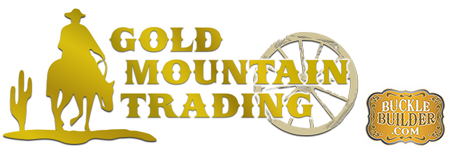 $100 min purchase Continental U.S. only
$100 min purchase Continental U.S. only 
The End of the Trail by James Earle Fraser 1876 - 1953
This lone figure on his weary horse is one of the most recognized symbols of the American West. By many it is viewed as a reverent memorial to a great and valiant people. To some Native Americans, however, it is viewed as a reminder of defeat and subjugation a century ago. The monumental, 18' plaster sculpture was created for San Francisco's 1915 Panama-Pacific International Exposition and received the exposition's Gold Medal for sculpture. The subject of immediate popular acclaim, the image was widely reproduced in postcard, print, curio and miniature form.
Although James Earle Fraser (who also designed the famed Indian Buffalo Nickel) hoped his masterpiece would be cast in bronze and placed on Presidio Point overlooking San Francisco Bay, material restrictions during the First World War made the project impossible. Instead, in 1920, the city of Visalia, California, obtained the discarded statue and placed it in Mooney Park, where it remained, in a gradually deteriorating condition, for 48 years. In 1968, the National Cowboy & Western Heritage Museum acquired this original plaster statue, restored it to its original magnificence, and made it a focal point of the museum.
In 1894, when James Earle Fraser completed his model of the End of the Trail, American civilization stretched from shore to shore. Most Euro-Americans believed the frontier period was over and that such progress was inevitable. Many viewed Native Americans as part of the past, a vanishing race with no place in the twentieth century. Popular literature portrayed Indian people as "savages," noble or otherwise. Fraser's The End of the Trail reflects this legacy: a nineteenth century Indian warrior defeated and bound for oblivion -- frozen in time.
By the 1890s, Native Americans knew their trail had become steep and rocky, but they believed it would continue. Confined mostly to reservations and ravaged by disease and starvation, the Indian population declined dramatically. Indian children were forced to attend federally supported boarding schools that attempted to replace traditional tribal values with American culture. Although denied citizenship and a voice in determining their future until 1924, Indian people persisted.
World War II brought dramatic changes to most Native American communities. Modern warriors enlisted in the armed forces, while other Indian men and women moved to urban areas to work in defense industries. Increased cultural pride following the war led many Indian people to seek employment and other opportunities in the non-Indian world. Others supported themselves within the old reservation communities. Today almost half of all Native Americans live in major metropolitan areas. From a low of approximately 250,000 in 1890, Native American population in the United States now numbers slightly over two million.
Modern Indian people have combined the best of traditional tribal values with the opportunities afforded by contemporary American society. Although some Native Americans still follow the time-honored ways of their ancestors, others have assumed prominent roles within society in education, politics, business, medicine and agriculture. Unlike Fraser's sculpture, "being Indian" has never been cast in stone. Today, Native Americans ride forward on a trail into the future. ![]()
Courtesy of National
Cowboy & Western Heritage Museum
Below is correspondence between
Gold Mountain Trading.
and
Old West Aficionado Jerry Lee Tyner about the first The End Of The Trail sculpture
being only 18 inches tall:
I have done a little more research
since my first letter to you and found that NOBODY knows for sure where the 18
inch sculpture is. I read where one fellow donated an 18 inch bronze which had
been handed down from his grand father to a museum, and declared a $25,000 deduction
on his taxable income. The internal revenue folks contested it and disallowed
the entire amount. The original owner of the statue was burglarized and it was
stolen plus the fact that the statue had not been copyrighted and many copies
were made early after it was originally made.
Best Regards
Jerry Lee Tyner B.R.S.
Old West Aficionado
Songster
=======
From the City of Waupun, Wisconsin:
"The original model of "The End of the Trail" was created by James Earl Fraser in 1894 when he was 17 years old. It's completed size was only 18 inches tall. Fraser was asked to replicate his masterpiece in plaster for the 1914 Panama Pacific International Exposition in San Francisco which was where Shaler first beheld the work of art.
The child of pioneer farmers, Shaler had contact with Native Americans living around nearby Lake Emily and was saddened by their disappearance over the years. As a tribute to the Native Americans he commissioned James Earle Fraser to cast the statute in bronze as a gift to the City of Waupun. It took two years to complete at a cost of $50,000 and was unveiled at its present site on June 23, 1929."
It drove James Earle Fraser crazy. But Gene Autry kept doing it.
As the finish to his rodeo act, Autry and his horse, Champion, would strike a pose, shoulders hunched, heads bowed, as the cowboy crowed to the crowd that they were portraying Fraser's famous painting, "End of the Trail."
You'd think Fraser might have loved the publicity. Guess again. "End of the Trail" wasn't a painting, it was a sculpture.
Autry could never seem to get it right. Fraser could never understand why.
